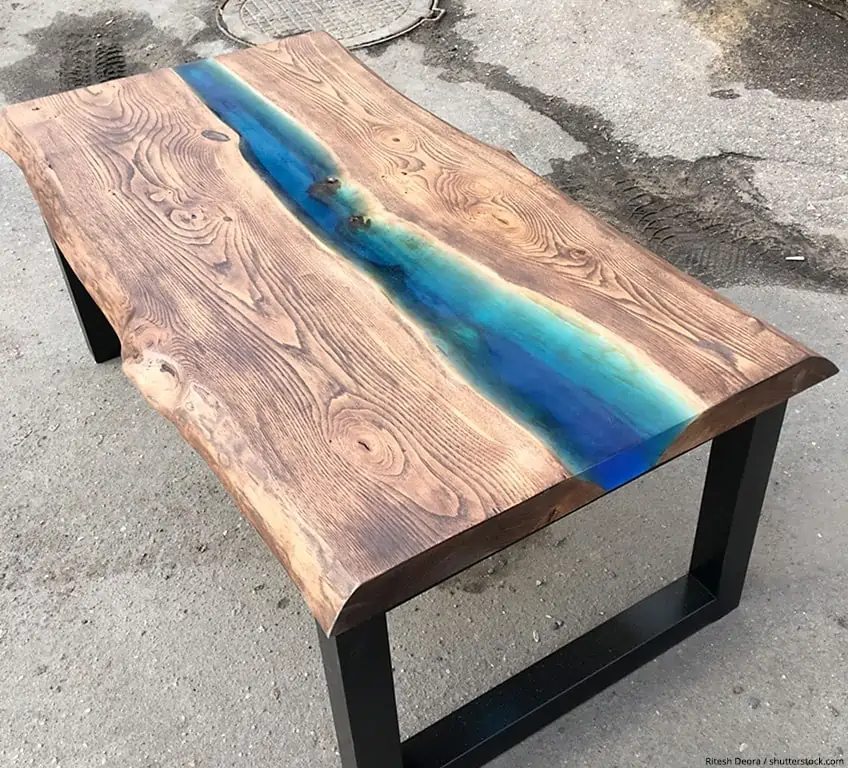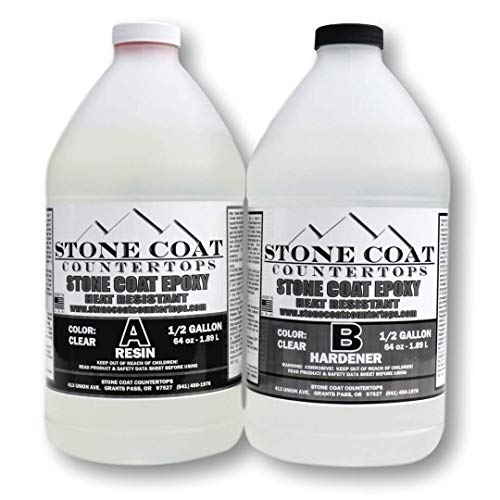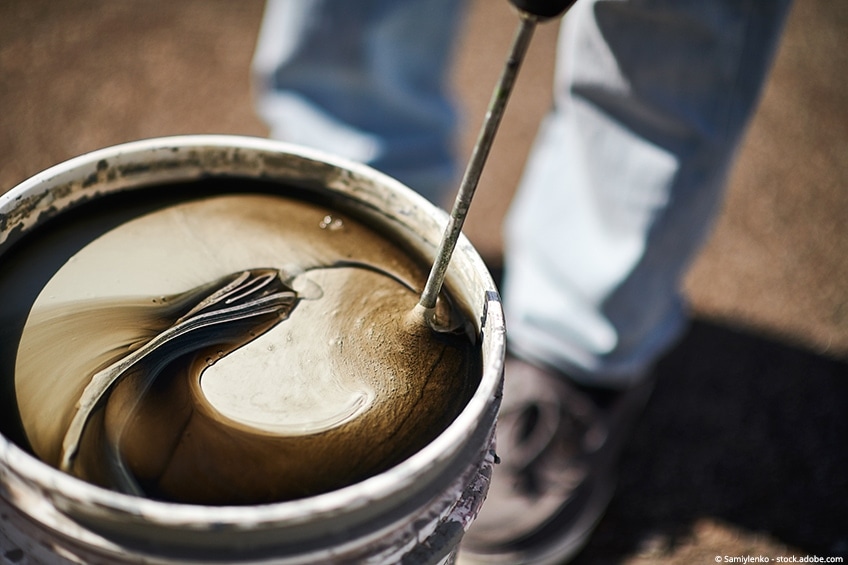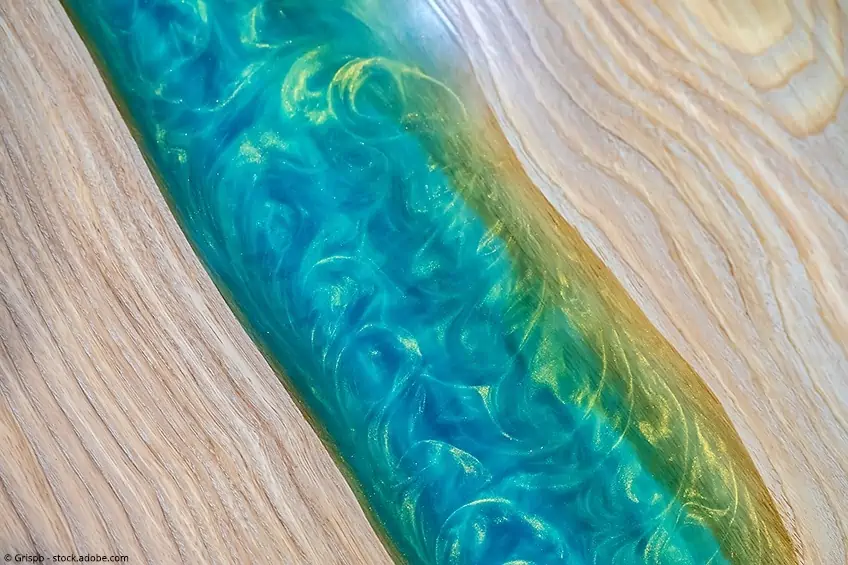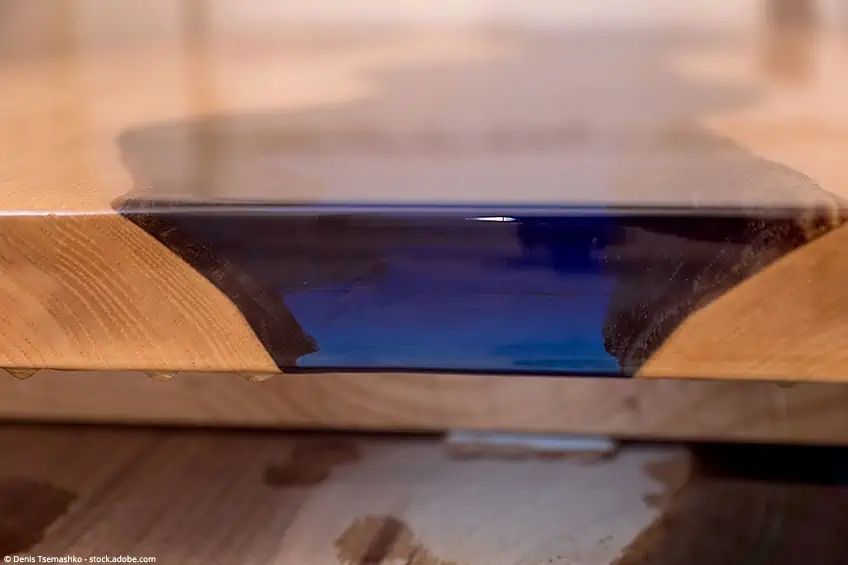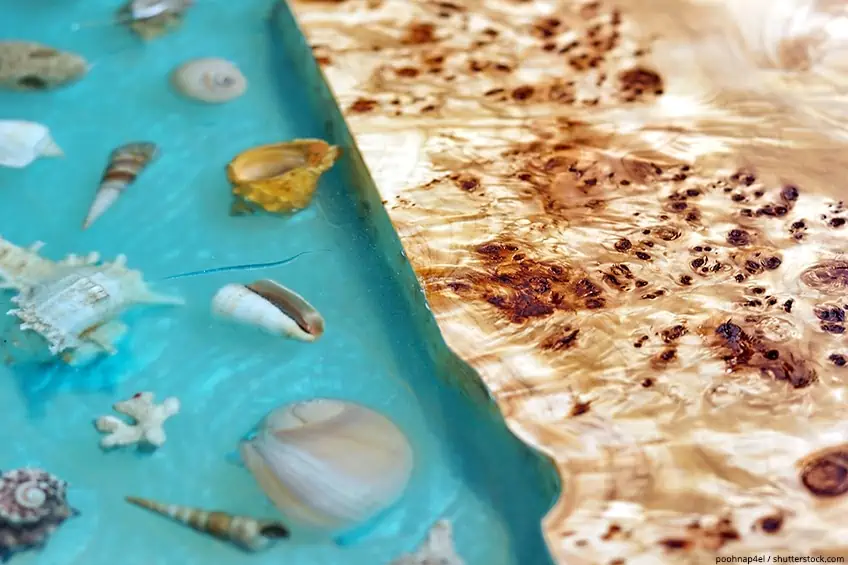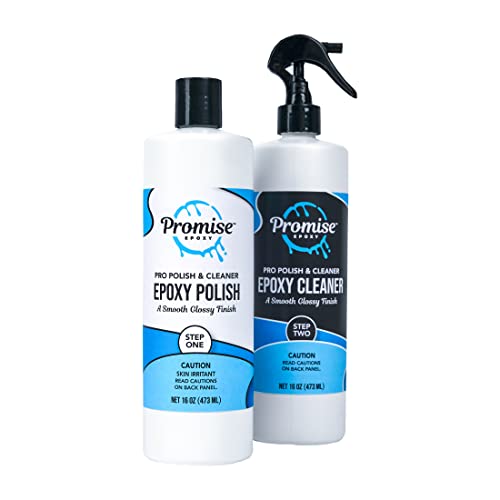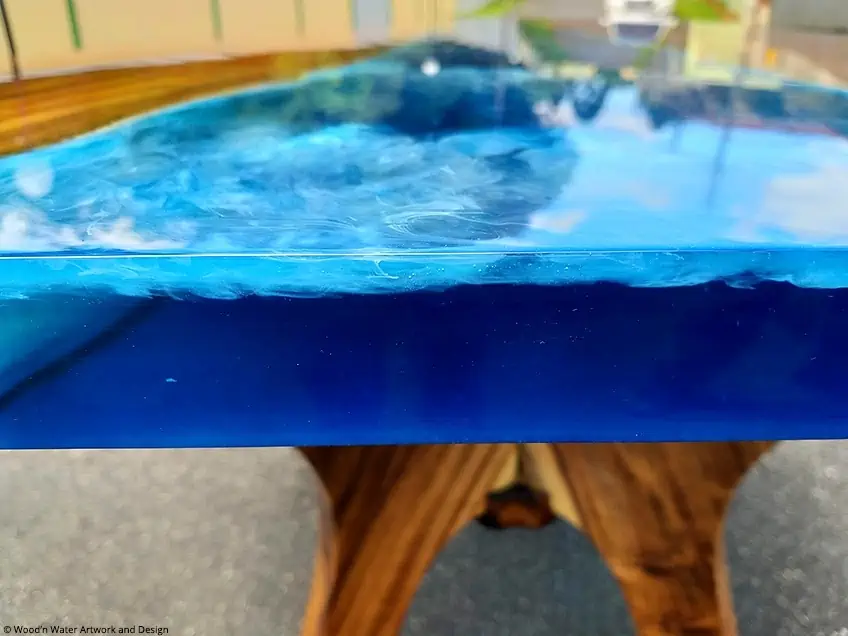How to make an Epoxy Resin River Table with Wood [Tutorial]
This post may contain affiliate links. We may earn a small commission from purchases made through them, at no additional cost to you. You help to support resin-expert.com
If you think that you need a professional craftsman to have a beautiful epoxy table, let us be the first to tell you that you don’t. If you have the stomach for it, below we’ve laid out a few helpful tricks as well as a short how-to detailing exactly how you can create an epoxy resin table that will leave your guests asking where you bought it. It might seem like quite the undertaking, but with the right tools, the right motivation, and a few pointers, soon you’ll be on your way to creating an epoxy resin table that would put even the most prestigious furniture store to shame.
Table of Contents
- Why Are Epoxy Resin Tables So Trendy Lately?
- Best Epoxy Resin for Pouring the Tabletop: INCREDIBLE SOLUTIONS Deep Pour Resin
- Best Tabletop Resin for Your Final Coat: STONE COAT Countertops Resin
- Choosing The Right Wood for Your Table
- Preparing Your Wood Board
- Preparing Your Workspace
- Create Your Own Epoxy River Table – Step-By-Step Instructions
- Covering With Crystal Clear Resin
- Getting Polyurethane Lacquer Professionally Sprayed
- Last But Not Least: Attach the Table Legs
- Video Tutorial on How to Make your Own Epoxy Table
- Frequently Asked Questions
Why Are Epoxy Resin Tables So Trendy Lately?
In recent months epoxy river tables have been all the rage all over the world. Although they seem to have a following all over the globe, the origin of this aesthetic movement seems to have originated in the good old USA. Their popularity seems the be growing exponentially, and why wouldn’t it? Epoxy resin tables fit virtually any aesthetic and feel at home in any space, whether you have a small apartment in New York, or having a well-deserved cup of bourbon on your ranch in the light of the Texas sunset, these tables just feel right.
How do epoxy river tables pull this off though? Well, it’s a combination of factors, but the primary reason seems to be that they have no aesthetic limit, allowing anyone to create one that fits their style, and the space they’re placing their epoxy river table in. Let’s face it, you know what your living space needs far better than the team over at the local IKEA does.
Best Epoxy Resin for Pouring the Tabletop: INCREDIBLE SOLUTIONS Deep Pour Resin
Finding the best resin for the meat of your resin table product can be a real head-scratcher. We think we’ve found the perfect product for the job though, and we think you’d benefit greatly from this amazing product. Here’s a short review of its attributes and how it might benefit you!
If you’re looking for a clear casting resin for your next tabletop project look no further than this amazing clear casting resin from incredible solutions. If you think that all clear casting resins are the same you aren’t alone, but you should know that not all are made quite as equally as one would be led to believe.
Why? Well, much like any other product on the market, resins tend to be made according to a budget, and depending on what a company is willing to spend, you could end up with a really good resin or a really poor one. Rest assured that the deep pour clear casting resin from the Incredible Solutions team is a premium one, but what makes it so great?
Well, aside from the large volume it sold in (which is just perfect for casting resin tables) this product is incredibly consistent throughout its use. Its premium formula ensures that bubbles and imperfections are minimal (which is ideal when pouring resin in these volumes).
What makes this resin particularly impressive is how easy it is to work with compared to other products in its class, its low viscosity formula ensures that you’re never pressed for time and minimizes the chances of overpour. This means that you can focus on getting each pour just right before letting it cure.
If these attributes still aren’t enough to convince you that this is the resin for you, maybe the fact that it’s an all-American product with a food-safe grading and has a waterproof grading will. You really can’t go wrong with a product like this; besides, they have an incredible customer service team waiting to help you with any hiccups or questions you might have regarding their product or the application you’ll be using it for.
- Thick pours up to 2" per application, low viscosity and long working time
- Super clear results, compatible with pigments and dyes
- 2 : 1 mix ratio by volume (100 A to 44 B by weight)
- Two-part formula (resin and hardener)
- It is formulated using real wood
- It is graded for varying temperatures
- It’s able to fill a void well
- It is a highly durable formula
- The consistency of the formula in quite thick which perturbs some users
- Expensive compared to other products in its class
- Relatively unknown brand
Best Tabletop Resin for Your Final Coat: STONE COAT Countertops Resin
Once you have the meat of your table filled up you might want to consider giving your masterpiece a final coat. They say that a workpiece is only as good as its finish, and if that is true you’ll be doing yourself quite the disservice if you decide not to try this one out. Here’s what we thought.
Now that you have the meat of the matter sorted it’s time for you to consider what your finishing touches will be. Besides sanding down the edges of your table or deciding whether you’d like to add some wood stain, you should consider what finishing coat you’ll be adding to your existing resin filler.
A good idea is to add a finishing coat that not only looks good but has the durability and flexibility to withstand whatever forces your table will be up against throughout its lifetime. This being said, we think that the Stone Coat Countertops team has done an excellent job of providing the quality and quantity of product needed for this undertaking.
What makes their product so special? Well, it’s pretty versatile, allowing you to add dyes or any other additions that might cross your mind, whether it be some Mica powder, glitter, or sequins depending on your preference.
What’s more, is that its heat resistant up to 470 degrees Fahrenheit and isn’t harmful to you or the environment (although you should probably still wear personal protective gear when working with resin of absolutely any type.
Still not sold? how about the fact that this product is completely self-leveling and requires little to no effort on your part for application, and it’s UV resistant, meaning that you can place your table in the great outdoors during those summer months without having to worry about any yellowing!
- High temperature Resin - Heat Resistant up to 500°F
- Crystal Clear and UV stable, zero VOC
- Cured in 24 hours, self leveling
PROS
- The two-part formula is great for finishing coats
- Sold in large volume ideal for table casting
- UV resistant formula for outdoor use
- Self-leveling formula for reduced bubbles
- Highly heat resistant and watertight
CONS
- Expensive
- Long full cure time
- Bottle ergonomics not ideal for pouring
Choosing The Right Wood for Your Table
If the secret to baking a good cake is choosing only the best ingredients, then the trick to creating the best epoxy river table is choosing the best wood. When it comes to epoxy resin tables the one aspect you don’t want to cheap out on is the quality of wood you select for your workpiece. Why? Your table is going to see a lot of mileage in its lifetime, and you’re going to be investing a lot of your time, money, and elbow grease in bringing it to life. The last thing you want is your hard work slowly (or quickly) falling apart in front of your eyes
The wood used should be as natural as possible. Here, for example, a board made from a tree trunk that is at least 4 cm thick is a good choice. Known commonly as “natural edge” bark looks particularly stylish here. You can find such a piece of wood in a good carpenter’s workshop, at a timber dealer, or online. Alternatively, you can of course use two wooden boards from the DIY store, which are cut into a slightly curved shape on one side using a jigsaw. Whether from a carpenter or the DIY store: the most important thing is that the wood is well dried. Ideally, the moisture content should be less than 12%.
Preparing Your Wood Board
You have two options for the preparation of the wood. Firstly, you can prepare the wood itself. For this, you need a circular saw and a planer to produce the right length and thickness, and then divide the wood down the middle.
On the other hand, you also have the option of buying the boards in the desired thickness and length or simply buying some wood board and having it cut and planned to fit your desired application. If you have little experience in processing wood, this option is far easier (don’t bite off more than you can chew). Additionally, purchasing machines capable of processing wood in this manner can be quite costly, so consider your options and your budget thoroughly. Even if your initial piece of wood is quite large, it is advisable to have it prepared by a professional before you process it further.
Before proceeding, you should make sure that your two boards are exactly the same length. Also, the side edges must be cut at right angles to the straight outer sides. Keep in mind that it’s also important that both pieces of wood have the same thickness. They should also be absolutely flat. If in doubt, it is advisable to commission a joiner to carry out the finishing work.

- Suitable for Makita Orbital Sanders
- 60 sanding discs included
- Grits from 1000 - 3000 for very shiny surfaces
- Includes a total of 42 sheets of assorted grit sandpaper
- Made from electro-coated waterproof silicon carbide
- Suitable for wet and dry sanding by hand or block
Preparing Your Workspace
Since epoxy resin is quite a sensitive substance, you should prepare your workspace appropriately before you begin casting. Very high temperatures, cold, or humidity can have a negative effect on the appearance and performance of your resin. In addition, unfavorable external conditions can affect the drying time of the resin.
The ideal temperature for processing epoxy resin is a minimum of 20° Celsius. This should also be considered during storage, even if the room temperature is an ideal 20° C, if the temperature drops significantly towards the floor the thermometer should only show 15° to 17° C.
If the epoxy resin were to be stored on the floor at these temperatures, tiny, unsightly bubbles could quickly form in the resin. These cannot be removed very easily even with a hot air dryer. Therefore, it is better to store the material on a workbench or shelf. Another important factor is that the work area should also be a dust-free, dry, and well-ventilated setting.
Create Your Own Epoxy River Table – Step-By-Step Instructions
Step 1: Removing the Bark and Sanding the Wood
The first step is the thorough removal of any remaining bark, e.g. with a chisel. Although the bark looks very nice, it does not form an ideal bonding surface for the epoxy resin. Once the bark has been removed you should work the edges again by hand with sandpaper, so that wood and resin can later combine optimally.
Next, sand the large surfaces of the wood smoothly. An electric sander is particularly suitable for this. You should start with 80 grit and then work your way up to 220 grit. After each grit size, the dust should be removed from the boards before continuing. The sides are best finished by hand with some sandpaper.
Finally, the wood must be cleaned extremely thoroughly, there should be literally no dust residue present. A vacuum cleaner is an excellent tool for this, but to be sure wipe the surface again with a microfiber cloth to get rid of the last fine sanding dust.

Step 2: Fill in Bumps and Cracks and Seal the Wood
Now all visible unevenness, cracks, and porous surfaces on the wood must be leveled. These are easily filled with crystal clear, unpigmented epoxy resin. If you want to correct any unevenness in unfavorably located areas on the edges, you can seal the edges in advance with very strong adhesive tape. This will prevent the resin from running over the edges of the wood afterward.
After the filled-in areas have dried and the whole surface is sealed, use a crystal-clear resin as you would for filling the cracks. You should apply this very generously over the entire wood surface. This sealing prevents possible outgassing from the resin layer, it is better to invest a little more money in a good brush that does not have weak bristles. Because once bristles have been stuck in the resin, it is very difficult to remove them from the resin again. The sealant must then dry very well. You should allow 5 hours for this regardless of the type of resin you’re using. The ideal temperature for drying is 18° to 24° C.
After curing you should slightly roughen the inner edges that will later come into contact with the cast resin by hand with some sandpaper. This will create the perfect base for the resin to bond with the edges.
Step 3: Build A Mold / Framework for The Tabletop
Next, a mold must be built in the desired length and size of the table. Simple MDF boards can be used for this. The whole thing sounds more complicated than it actually is, however, it has to be measured and worked out very precisely and carefully. MDF boards with a thickness of 16 mm, for both the underside and the sides, have proven to be very suitable for the production of the mold.
The side panels should protrude the actual tabletop by approx. 15 mm. There are two options for joining the underside with the side panels: either the individual parts can be screwed together or joined together with hot glue.
Images: left: brizmaker / shutterstock.com, right: Rawpixel.com / shutterstock.com
- 6 Sheets of 1/4 inch medium density fiberboard
- Can be painted, engraved, distressed, glued, and embellished
- Dimensions per sheet is 11 x 14 inches
- Multiple tool interchangeable lithium ion battery system
- Cordless and compact with 24-position clutch to prevent stripping
- Includes battery, charger, 25 bits, 4 drivers, and magnetic bit tip holder
- A 3 - 5 minutes fast heating glue gun
- Includes an anti-heat cover and safe power switch
- Multi-purpose glue gun including 30 glue sticks
To seal the edges afterward, it is best to use clear sanitary silicone. Here, working very carefully is essential to ensure that the mold is 100 % tight at the end. Otherwise, liquid epoxy resin will leak out.
Now a release agent is applied to the finished mold. This is a very important step, as the resin could otherwise adhere to the MDF boards after drying. In this case, it would be almost impossible to release the tabletop from the mold without damaging it. It would be possible to use adhesive tape to cover the entire mold or, alternatively, liquid release wax. Spraying with Teflon spray or silicone spray (this should be applied in up to three layers until the surface is smooth) is also suitable for this purpose.

- 1/10-gal. cartridge gun with thrust ratio of 10:1 for low viscosity materials
- Smooth pressure instead of ratchet-style rod requires less pressure
- Retracting rod after each trigger pull helps to prevent dripping
- 100% waterproof to seal out water, air, and moisture
- Ready in 30 minutes and will not yellow, shrink or crack
- Suitable for interior and all-weather exterior use
- Durable high impact ABS plastic with limited lifetime warranty
- Includes top reading feature, level plumb and 45-degree vial
- Magnetic strip for use in metalwork
Step 4: Inserting the Wood into The Mold
Make sure that the work surface on which the mold rests is really 100% balanced. If not, the resin will become skewed after filling (and possibly leak). Once this has been ensured, the wood can then be placed into the mold. To do this, the wood is pushed into the position that it should have when the table is finished and then fixed with several parallel clamps. If you are planning a slightly smaller model, the wood can alternatively be fixed with heavy objects such as stones. However, you should always bear in mind that any object used to fix the wood might come into contact with the resin.
In order to prevent the resin from later spilling over onto the entire table and not just in the gutter provided for it, it is advisable to draw a kind of barrier of sanitary silicone along the inner edges at a distance of 1 to 2 cm.
Step 5: Mix Epoxy Resin
Calculate the right amount of epoxy resin for your epoxy resin river table. This can be a little bit complicated. For this reason, we have created an epoxy resin calculator to help you out:
In the next step, you will mix the epoxy resin. Important: When working with resin please always wear safety glasses, breathing protection, and nitrile gloves!
Next, you need a sufficiently large bucket. It would be ideal if this bucket holds the entire volume of resin or the first layer of resin. Please choose a sufficiently large bucket so that nothing goes wrong (accidents happen and resin is hard to clean up). Also, the bucket should preferably be wider than it is high so that not too much heat is generated.
This perfectly illustrates just how sensitive resin is as a material. From a certain amount and height, it starts to get extremely hot and in extreme cases boils and thus becomes either cloudy or directly unusable. Therefore, it may be necessary to cast the resin in several layers. The product used is the most important factor here. How many layers are required, or the maximum layer height and the maximum amount to be mixed ultimately depends on the thickness of your tabletop. If in doubt, observe the maximum layer of thickness specified by the manufacturer or decide directly for a special epoxy resin as described above, which can be cast directly in one layer.
Images: left: Wood’n Water Artwork and Design, right: futuristman / shutterstock.com
- Powerful 8-amp motor delivers 0-2,500 rpm for heavy-duty applications
- 3/8-Inch VSR soft and comfortable pistol-grip drill with keyless chuck
- variable-speed trigger, convenient reversing switch
- Fits all standard drills for mixing in 1 to 5 gallon buckets
- Durable, rust proof, and easy-to-clean zinc plated steel
- Non-slippage hex head design with lifetime guarantee
- Heavy-duty, corrosive-resistant bucket with thick wall construction
- Molded-in spout for easy and accurate pouring
- Holds 2.5 gallons and measures 26.03" L x 29.21" W x 30.48" H
It is also particularly important that the mixing ratio recommended by the manufacturer is observed and that the individual components are then thoroughly mixed. A drill with a mixer attachment has proven to be the best solution for this.
After mixing, air bubbles that have formed in the resin can be easily removed with a blow torch or heat gun. The rule here is as much as necessary, as little as possible. If the resin is heated too much, it will be damaged.
Step 6: Coloring the Resin and Creating a Water Effect
- 24 Colors Mica Powder Set with each color 0.35oz
- Made from vivid and vibrant natural ingredients and widely used in handmade crafts
- Non-toxic and Premium Quality, does not fade or oxidize
- 15 Vibrant Colors, usable with all kinds of epoxy resin
- Non-toxic and odorless
- High Concentrated Resin Pigment, easy to use
Especially when casting a water effect, it quickly becomes clear why the use of a special epoxy resin is recommended. This quality resin can be cast very easily in one step, giving you an instant payoff.
If you want to achieve the popular water look after mixing the two resin and hardener, the appropriate color pigments must now be added to the epoxy resin. To do this, divide the resin into two containers (the ratio of 1:1.5 would be preferable, for example). To achieve the water effect, color the larger part of the resin with a metallic pigment in turquoise and the smaller part with a matt blue pigment. This mixture only achieves the typical water look, and generally speaking, there are no limits to the choice of color.
When filling in the epoxy resin there are (again) two possibilities. You can either pour the resin from the two containers into the mold or simultaneously from one side each. Slight circular movements, especially with the metallic epoxy resin, make the final result look lively. Remember that you are responsible for the “flow’ in the resin’s appearance.
The resulting pattern can be changed with a wooden stick or similar object.
Afterward, the epoxy resin has to be allowed to cure completely (follow the manufacturer’s instructions).
Images: left: © Suteren Studio – stock.adobe.com, right: Suteren / shutterstock.com
Step 7: Creating A Design with Crystal Clear Resin
In addition to the typical water look, there is an infinite number of different designs that are capable of turning your DIY table into a real work of art. An aesthetic that is Just as nice to look at is a River Table with crystal clear resin and embedded objects. For this, the first layer of crystal-clear resin is poured between the two wooden boards. This process should be done very quickly, but still with relative caution.
Afterward, a quick walk over the epoxy resin with a hot air dryer is done. Extreme caution is required here. If the resin is exposed to the extreme heat of the hairdryer at the same spot for longer than 3 seconds, this can cause, among other things, a burning of the material. The final result is an unsightly yellow epoxy.
Images: left: Marco Zamperini / shutterstock.com, right: Wood’n Water Artwork and Design
Now follows the so-called “B Stage”, the second layer. When this layer is poured, the first layer should not yet be completely hardened and still slightly sticky on the surface. You must not miss this interval, as the next layer can only bond optimally with the first one if the substrate is slightly sticky. If the first layer is already completely dry, wait until the resin is completely cured. Then sand the surface with a 220 grain, clean it thoroughly and then pour the second layer.
If you want to embed decorative elements such as crystals or pebbles in the epoxy resin, then these should be added to the second layer. This has the advantage that they can no longer sink to the bottom.
Now the resin layer can be filled in to just above the edge and then allowed to dry completely again. The manufacturer’s instructions should again be observed closely.
Step 8: Removing the Casting from The Mold (and Sanding)
Next, the cast tabletop is released from the mold. To do this, remove all screws and parallel clamps and carefully loosen the tabletop from the mold using a chisel and a plastic hammer. Afterward, the tabletop can be sanded. This work can be done by hand. However, an orbital sander makes the task much easier. Start with an 80 grit and work your way up to 400 grit and in the end, there should be no more resin on the wood.
For perfectly smooth edges, these can be additionally processed with a router before sanding or, if necessary, cleanly re-cut or plane again with a circular saw. However, these steps are not absolutely necessary. As a small tip: The higher the grain of the sanding paper, the lighter the surface of the Epoxy River Table will be at the end.

Step 9: Polishing and Oiling the Tabletop
Now for the finish in order to protect the wood optimally. On the one hand, you have the possibility to achieve a natural, matt look. To achieve this, the finished tabletop – and especially the resin river – should be thoroughly polished with a polishing machine and polishing paste. This procedure ensures that all traces of sanding are removed, and a silky surface is achieved.
For a matt appearance, oil is then applied evenly over the entire tabletop, e.g., with a soft cloth. This method is extremely simple and seals the wood perfectly. Additionally, only a single application is required here.
For the epoxy resin polishing process, we have prepared a separate tutorial for you to enjoy.

- Powerful compact orbital polishing machine
- Digital Screen and detachable handle
- Polishing set included, paste trays in 6 inch and 7inch, polishing pads, and carbon brush
- Developed for reaching that brilliant shine on Epoxy Resin surfaces
- Removes all imperfections from the surface including scratches and scuffs
- Easy removing of the polishing paste with the included cleaner
- Penetrates, protects, and enhances natural color and grain of wood
- Use to extend and fortify oil-based paints and coatings
- Dries within 12-18 hours depending on environmental conditions
Covering With Crystal Clear Resin
If you prefer a glossy look, you could alternatively coat the surface of the tabletop with crystal-clear resin. To do this, start with the underside of the tabletop and first apply a sturdy adhesive tape around the top, which should protrude 1 to 2 cm. This prevents the resin from dripping down the sides.
The resin is then poured over the surface and evenly distributed over the entire surface. A plastic spatula, for example, is suitable for this. Briefly go over the resin with a heat gun to avoid bubbles. Afterward, the whole surface must be allowed to completely harden once more.
Since the first layer is only the base, you should always pour the second layer of resin. Here too, the first layer should be sanded briefly to ensure a successful bond between the two layers.
After curing, you can now remove the adhesive tape on the sides. Now the edge of the painted underside is taped (at least 5 cm wide).
Next, you should turn the tabletop over and put something suitable underneath it, such as leftover pieces of wood. To avoid damage to the lacquered side, you could also place a fleece underneath for added cushioning.
The tabletop must be 100% level so that the resin can now be poured over the top of the table. After the subsequent distribution with a spatula and the drying time elapses, the remaining adhesive tape can now be removed, and all sharp edges can be sanded with fine sandpaper.
Images: Wood’n Water Artwork and Design / www.woodnwater.com.br
Getting Polyurethane Lacquer Professionally Sprayed
For a perfect, mirror-smooth surface, a professional must be commissioned. After all, a polyurethane coating is particularly critical to this exercise. This kind of coating can only be done with special equipment, a paint booth, and a lot of know-how. Furthermore, this technique is very costly, but the advantage of a polyurethane coating is that you will have very high durability, e.g. to scratch marks. However, with a high-quality workpiece like the self-built Epoxy River Table, the investment in such a coating is worth considering for most crafters. After all, this is a labor of love.
Last But Not Least: Attach the Table Legs
- In order to finally finish the miracle resin table, you can screw on legs of your choice. With classic wooden legs, the table looks rustic, but at the same time, slightly noble. Stylish metal table legs turn the table into a modern piece of furniture.
- Heavy duty high quality steel table legs, 28.4”high and 25.6”wide
- Maximum load-bearing weight of each leg is about 1000lbs
- Suitable for tables and desks in a black paintable finish
Video Tutorial on How to Make your Own Epoxy Table
Frequently Asked Questions
How much is Epoxy Resin for a River Table?
The price of epoxy resin you need for your river table depends on the size of the tabletop. A resin coffee table will need you to invest $200.00 or upwards, while a resin dining table can cost you up to $700.00.
Do Epoxy River Tables last?
If properly built epoxy river table will last forever if you treat it the right way. Don’t put it outside and under harsh UV-light conditions, as this could cause yellowing of the resin part and cracks in the wood.
Are Epoxy Tables Heavy?
Epoxy tables are very heavy because the epoxy resin is heavier than most woods with up to 0.05 pounds per cubic inch. Remember that even though the dimensions of the table have remained the same, the density of the workpiece would have increased considerably, which is what causes the increase in weight.


